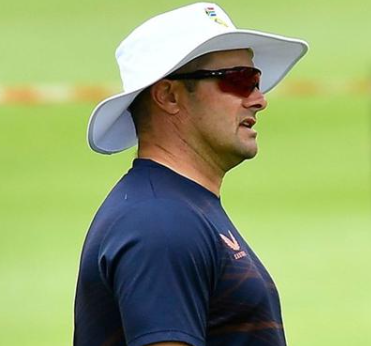One of the biggest takeaways from the first T20I was the contrasting approaches to playing on a pitch with turn
India’s batters managed to keep the scoreboard ticking, rotating the strike and taking calculated risks, while South Africa’s batters often found themselves bogged down, facing numerous dot balls.
India’s balanced approach allowed them to post a competitive total, which their bowlers were then able to defend effectively.
Ravi Bishnoi’s ability to “muddle the seam up,” as praised by Mark Boucher, represents a shift in how spinners are evolving in the modern game. With batsmen constantly improving their ability to read spin, bowlers need to find innovative methods to stay ahead.
Bishnoi’s success with seam manipulation adds a refreshing dimension to spin bowling, particularly in the T20 format.
His journey will undoubtedly be followed by fans and cricket experts as he redefines the role of a leg-spinner in the fast-paced world of T20 cricket.

Also Read: Shimron Hetmyer (Cricketer) Bio, Age, Career, Family, Net Worth And More
Table of Contents
Mark Boucher Criticizes South Africa’s First T20I Loss to India
In the first T20I match between South Africa and India on November 8, 2024, South Africa fell short of their 203-run target, losing by 61 runs.1
Mark Boucher, former South Africa wicketkeeper-batter and seasoned analyst, highlighted South Africa’s struggle against spin as a significant factor in their defeat.
Boucher pointed out that David Miller, particularly, seemed lost against spin, failing to capitalize on a pitch that offered subtle assistance to bowlers.
In this article, we will explore the various aspects of South Africa’s performance as analyzed by Boucher and the critical areas where the Proteas faltered in the game.
Apparently SSP1 as well 🙏🏼 https://t.co/DZFZU8425V
— Mark Boucher (@markb46) May 17, 2020
The Impact of Spin: David Miller’s Struggles
One of the main observations Boucher made was David Miller’s difficulty in reading spin during his innings. With India’s spinners operating effectively, Miller’s inability to rotate the strike became a glaring issue.
In the 11th over bowled by Ravi Bishnoi, Miller played five consecutive dot balls, barely making contact with the deliveries.
This pressure eventually forced him to take a single, disrupting South Africa’s momentum and their chances of staying competitive in the chase.
Klaasen’s dismissal after hitting a maximum was a decisive moment in the game. Boucher described how Klaasen’s brief spark of aggression failed to translate into a prolonged partnership, leaving South Africa in a vulnerable position.
Losing both Miller and Klaasen in the same over left South Africa with limited batting options, effectively ending their chances of mounting a successful chase.

Mark Boucher: Take on Miller’s Performance
Boucher noted that Miller “wasn’t picking a thing at all,” reflecting a broader problem with South Africa’s approach to spin.2
The former wicketkeeper-batter described how Miller missed several deliveries in one over, struggling against Bishnoi’s line and variations.
According to Boucher, Miller’s struggles highlighted how Indian spinners found assistance from the pitch, something South African bowlers failed to exploit.
While David Miller struggled against spin, Heinrich Klaasen showed some resistance, briefly injecting hope into South Africa’s chase. In the 12th over, he struck a six against Chakravarthy, indicating an intent to counterattack.
However, Klaasen’s efforts were short-lived, as Chakravarthy soon dismissed him, followed by Miller’s departure in the same over.
South Africa’s Lack of Adaptation to Subtle Pitch Help
Boucher emphasized the subtle assistance the pitch provided to spinners, suggesting that South Africa’s bowlers missed an opportunity to make use of it.
While India’s spinners, particularly Varun Chakravarthy and Bishnoi, effectively utilized the turn and variation the surface offered, South Africa’s bowlers didn’t make similar adjustments in their approach.
This lack of adaptation was costly, as India’s bowlers were able to contain the Proteas’ middle order and break their momentum.
The contrast between the Indian and South African spinners was stark, as Indian bowlers managed to keep South African batters under consistent pressure. Chakravarthy, for instance, dismissed both Miller and Heinrich Klaasen in the same over, derailing South Africa’s chase.
Boucher pointed out that had South Africa’s bowlers been able to exploit the same subtle help from the pitch, they might have contained India’s total to a manageable level.

Mark Boucher’s Analysis on South Africa’s Tactical Shortcomings
Boucher’s post-match analysis on JioCinema highlighted not only the players’ performances but also South Africa’s tactical shortcomings.3
He discussed how South Africa failed to develop a coherent strategy against India’s spinners, a key area that India’s bowlers effectively exploited.
According to Boucher, South Africa’s batters needed to rotate the strike more frequently and avoid prolonged sequences of dot balls, which would have kept the pressure on Indian bowlers and prevented them from settling.
Boucher suggested that the Proteas’ strategy against spin bowling needs reassessment, especially when playing on pitches that offer some turn.
He emphasized that rotating the strike and looking for singles could have mitigated the impact of India’s spinners, allowing South Africa to build partnerships. Without a strategic approach to counter spin, Boucher argued, South Africa’s middle order was bound to struggle.
South Africa’s Batting Collapse in Context
South Africa’s batting collapse in the middle overs underscores the importance of building partnerships in T20 cricket.
The Proteas began their innings positively, but once India’s spinners gained control, they lost momentum rapidly.
The quick dismissals of key players, such as Klaasen and Miller, left South Africa’s lower order exposed to India’s bowling attack.
Boucher noted that while T20 cricket demands aggressive scoring, the importance of building partnerships cannot be overlooked. He suggested that Miller and Klaasen could have focused on finding singles to create a foundation before launching big shots.
By losing both set batters in the same over, South Africa’s middle order was left without experienced hitters, which, in turn, affected their scoring rate in the later stages of the innings.

Also Read: Hayley Matthews (Cricketer): Who Is She? Bio, Wiki, Age, Career, Net Worth 2024 and Net Practice
Mark Boucher’s Insights on Ravi Bishnoi’s Variations
“He Changed the Seam Up”
In cricket, particularly in the T20 format, every small variation can make a significant difference.
The role of a spinner becomes critical, especially in subcontinental conditions or pitches with some assistance for turn.
Ravi Bishnoi, known for his deceptive leg spin and googlies, has become a talking point in the cricket world, particularly with Mark Boucher, the South African coach, praising his unique approach to spinning the ball.
Let’s explore Boucher’s analysis of Bishnoi’s technique, particularly focusing on how subtle seam variations are helping the young Indian bowler achieve remarkable results on the field.
Ravi Bishnoi emerged as one of India’s most promising young spinners, recognized for his remarkable performances at the Under-19 level and later in the Indian Premier League (IPL).
Born in Rajasthan, Bishnoi quickly became known for his impressive leg spin and especially his googly, which has troubled many batsmen.
His success in the IPL paved the way for his debut in international cricket, where he continues to showcase his skill and unique bowling variations. Bishnoi’s ability to vary his deliveries and adapt to different match situations has garnered attention from players, coaches, and cricket enthusiasts worldwide.

Mark Boucher: Observing Bishnoi’s Seam Variations
- Mark Boucher, South Africa’s head coach and a former wicketkeeper-batsman, is known for his sharp cricketing insights.
- Boucher’s experience as a wicketkeeper makes him an excellent judge of bowlers’ skills, particularly spinners.
- He pointed out that Bishnoi’s effectiveness was not just about the traditional leg-spin or googly but lay in his ability to “muddle the seam.”
- This technique, which involves changing the seam position subtly, helps the bowler exploit any available pitch conditions.
- According to Boucher, these variations make it harder for batsmen to read the ball’s movement, especially in low-light conditions or under stadium lights.
- Spin bowling relies heavily on grip, wrist movement, and seam positioning. A spinner’s seam variation can impact how the ball behaves after pitching.
- By changing the seam, a spinner like Bishnoi can affect whether the ball skids, turns, or bounces, depending on the pitch.
- When Boucher noted that Bishnoi “changed the seam up,” he was acknowledging Bishnoi’s skill in tweaking his deliveries’ seam position to adapt to the surface.
- A seam pointing towards the slip fielders might cause more turn, while a straighter seam position could make the ball skid faster. Bishnoi’s technique of using these variations effectively keeps batsmen guessing.
Why Seam Variation is Effective Against Modern Batsmen
In today’s T20 era, batsmen have become adept at picking traditional spin techniques, especially with frequent exposure to different bowling styles.
A skilled batsman can often read wrist position, speed, and spin direction, which makes subtle variations like seam positioning highly effective. When a bowler like Bishnoi varies the seam, it creates doubt in the batsman’s mind, disrupting their judgment of the ball’s direction and behavior.
This is particularly useful in T20 cricket, where even a momentary lapse in the batsman’s timing can lead to a wicket. Bishnoi’s seam manipulation adds an extra layer of deception to his already impressive skill set.
Having been one of the world’s top wicketkeepers, Mark Boucher brings a unique perspective when analyzing bowlers. As a keeper, he spent years observing the ball’s movement off the pitch, giving him an edge in assessing the subtleties of spin bowling.
In his comments about Bishnoi, Boucher explained how wicketkeepers often look for clues in the bowler’s wrist or seam position. Bishnoi’s seam muddling, according to Boucher, makes it challenging not only for batsmen but also for keepers to pick up the ball’s movement. This level of unpredictability can be a game-changer in tight matches.
Also Read: Shan Masood (Pakistan Cricketer): Who Is He? Bio, Wiki, Age, Career, Wife and More




